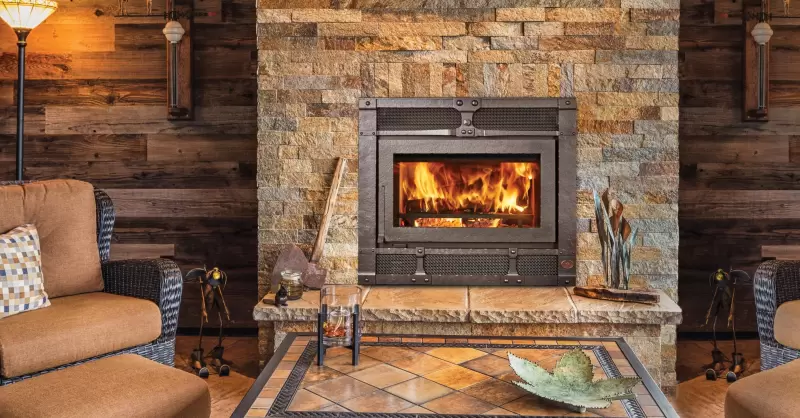Over here, you’ll get to know what is a zero clearance fireplace. Zero clearance fireplaces, also known as ZC fireplaces, are specially designed units that offer flexibility in installation by eliminating the need for extensive clearances around the appliance. This detailed article aims to explore the definition, types, features, benefits, and considerations of zero clearance fireplaces.
What Is A Zero Clearance Fireplace?
Grasping the Concept:
- Minimal Clearances: Zero clearance fireplaces are engineered to require minimal distances from combustible materials, walls, or floors during installation.
- Versatile Installation: Designed for easy installation in various locations without the need for traditional masonry fireplaces’ extensive clearances.
Types of Zero Clearance Fireplaces
Varieties and Options:
- Gas Zero Clearance Fireplaces: Utilize gas as a fuel source, offering convenience, efficiency, and customizable features.
- Wood-Burning Zero Clearance Fireplaces: Operate with wood fuel, providing a traditional ambiance with modern installation flexibility.
- Electric Zero Clearance Fireplaces: Emulate flames and heat via electricity, ideal for spaces where traditional venting is not feasible.
Also Read : What Is An ACD?
Zero Clearance Fireplace: Features and Functionality
Characteristics and Advantages:
- Insulated Construction: Designed with fireproof materials and insulation, allowing proximity to combustible surfaces.
- Versatile Installation: Can be placed against walls, in corners, or within various room configurations due to reduced clearance needs.
Also Read : What Is Enhanced On Spotify?
Zero Clearance Gas Fireplaces vs. Wood-Burning Models
Fuel Sources Comparison:
- Gas Fireplaces: Offer convenience with instant ignition, controlled heat output, and cleaner operation without wood handling or ash cleanup.
- Wood-Burning Fireplaces: Provide a traditional, crackling fire experience but require more maintenance and produce more particulate emissions.
Cost Considerations of Zero Clearance Fireplaces
Price Factors:
- Installation Costs: Generally, zero clearance fireplaces might involve lower installation expenses compared to traditional masonry units.
- Unit Variations: Prices vary based on size, features, design, and fuel type of the zero clearance fireplace.
Venting Requirements for Zero Clearance Fireplaces
Chimney and Venting Needs:
- Direct Venting Systems: Some models may require specific venting or flue systems, while others may offer vent-free options.
- Chimney Not Always Required: Zero clearance fireplaces with direct venting often don’t need a traditional chimney, enhancing installation flexibility.
Identifying a Zero Clearance Fireplace
Recognition and Inspection:
- Manufacturer’s Specifications: Refer to the manufacturer’s information or labeling to identify if the fireplace is a zero clearance model.
- Consultation with Experts: Seek guidance from professionals or inspectors to confirm the fireplace type and installation requirements.
Best Zero Clearance Gas Fireplaces and Considerations
Selection and Factors:
- Brand Reputation: Consider reputable brands offering quality, safety, and warranty assurances.
- Sizing and Efficiency: Choose a model that suits your space and heating requirements while ensuring energy efficiency.
Zero Clearance Fireplaces and Masonry Comparisons
Differentiation Points:
Traditional Masonry Fireplaces: Distinguished by their brick or stone construction, requiring significant clearances and extensive installation efforts.
Zero Clearance Advantages: Offer convenience in installation, reduced clearances, and often more cost-effective solutions.
To read about more informational things you have to visit ranyy.com
FAQ
What Does Zero Clearance Mean?
Zero clearance means the fireplace has its own insulation and it needs zero inches of clearance (distance) from combustible materials in the home. Basically a zero clearance fireplace is a self-contained firebox that is designed to be installed almost anywhere in your home.
Are Zero Clearance Fireplaces Safe?
Zero clearance wood fireplaces are not only safe but also convenient and stylish for the modern home.
What Is The Difference Between A Gas Fireplace And A Zero Clearance Fireplace?
A gas fireplace can also be identified as a zero clearance gas fireplace or direct vent gas fireplace. A gas fireplace has certain features unique from other types of fireplace units. A zero clearance fireplace refers to the lack of combustible materials around the fireplace.
What Is The Difference Between A Masonry And A Zero Clearance Fireplace?
While brick and ceramic are the most common materials used for the internal, or working, components of a masonry fireplace, the face material can also include stone, marble, granite, travertine and tile. Zero Clearance (or ZC) fireplaces are pre-manufactured metal fireboxes with coinciding metal flue pipe.
Conclusion: Embracing Versatile Fireplace Solutions
Zero clearance fireplaces present modern, adaptable heating solutions, offering flexibility in installation without compromising safety or efficiency. Their versatile design, minimal clearances, and diverse fuel options cater to various preferences and space configurations.
I have addressed all the queries and topics mentioned below mentioned in this article
what is a zero clearance fireplace grate
what is a zero clearance gas fireplace
what is a zero clearance fireplace?
what is a zero clearance wood burning fireplace
What is a zero clearance fireplace wood burning
What is a zero clearance fireplace gas
What is a zero clearance fireplace electric
What is a zero clearance fireplace cost
does a zero clearance fireplace need a chimney
how do i know if i have a zero clearance fireplace
best zero clearance gas fireplace
masonry fireplace
